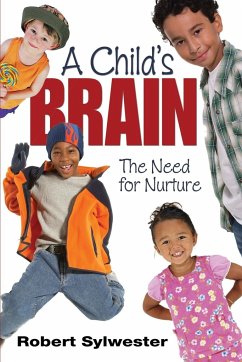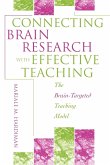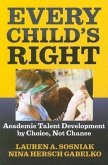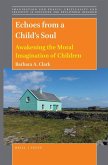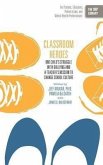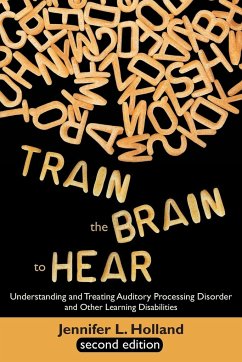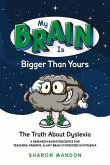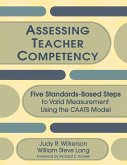- Broschiertes Buch
- Merkliste
- Auf die Merkliste
- Bewerten Bewerten
- Teilen
- Produkt teilen
- Produkterinnerung
- Produkterinnerung
Written for parents and educators, this guide explains the latest neuroscience research regarding how a child's brain works and how to nurture children for optimal development.
Andere Kunden interessierten sich auch für
![Connecting Brain Research With Effective Teaching Connecting Brain Research With Effective Teaching]() Mariale M. HardimanConnecting Brain Research With Effective Teaching50,99 €
Mariale M. HardimanConnecting Brain Research With Effective Teaching50,99 €![Every Child's Right Every Child's Right]() Lauren A SosniakEvery Child's Right28,99 €
Lauren A SosniakEvery Child's Right28,99 €![Echoes from a Child's Soul Echoes from a Child's Soul]() Barbara ClarkEchoes from a Child's Soul34,99 €
Barbara ClarkEchoes from a Child's Soul34,99 €![Classroom Heroes: One Child's Struggle with Bullying and a Teacher's Mission to Change School Culture Classroom Heroes: One Child's Struggle with Bullying and a Teacher's Mission to Change School Culture]() Jeff KrukarClassroom Heroes: One Child's Struggle with Bullying and a Teacher's Mission to Change School Culture15,99 €
Jeff KrukarClassroom Heroes: One Child's Struggle with Bullying and a Teacher's Mission to Change School Culture15,99 €![Train the Brain to Hear Train the Brain to Hear]() Jennifer L. HollandTrain the Brain to Hear31,99 €
Jennifer L. HollandTrain the Brain to Hear31,99 €![My Brain Is Bigger Than Yours My Brain Is Bigger Than Yours]() Sharon MandonMy Brain Is Bigger Than Yours12,99 €
Sharon MandonMy Brain Is Bigger Than Yours12,99 €![Assessing Teacher Competency Assessing Teacher Competency]() Judy R. WilkersonAssessing Teacher Competency43,99 €
Judy R. WilkersonAssessing Teacher Competency43,99 €-
-
-
Written for parents and educators, this guide explains the latest neuroscience research regarding how a child's brain works and how to nurture children for optimal development.
Produktdetails
- Produktdetails
- Verlag: Corwin
- Seitenzahl: 200
- Erscheinungstermin: 9. September 2010
- Englisch
- Abmessung: 229mm x 152mm x 11mm
- Gewicht: 298g
- ISBN-13: 9781412962711
- ISBN-10: 1412962714
- Artikelnr.: 30943373
- Herstellerkennzeichnung
- Libri GmbH
- Europaallee 1
- 36244 Bad Hersfeld
- gpsr@libri.de
- Verlag: Corwin
- Seitenzahl: 200
- Erscheinungstermin: 9. September 2010
- Englisch
- Abmessung: 229mm x 152mm x 11mm
- Gewicht: 298g
- ISBN-13: 9781412962711
- ISBN-10: 1412962714
- Artikelnr.: 30943373
- Herstellerkennzeichnung
- Libri GmbH
- Europaallee 1
- 36244 Bad Hersfeld
- gpsr@libri.de
Robert Sylwester is an Emeritus Professor of Education at the University of Oregon who focuses on the educational implications of new developments in science and technology. He has written 20 books and curricular programs and 200+ journal articles. His most recent books are The Adolescent Brain: Reaching for Autonomy (2007, Corwin Press) and How to Explain a Brain: An Educator's Handbook of Brain Terms and Cognitive Processes (2005, Corwin Press). He received two Distinguished Achievement Awards from The Education Press Association of America for his syntheses of cognitive science research, published in Educational Leadership. He has made 1600+ conference and staff development presentations on educationally significant developments in brain/stress theory and research. Sylwester wrote a monthly column for the Internet journal, Brain Connection, throughout its 2000-2009 existence, and is now a regular contributor to the Information Age Education Newsletter (http://i-a-e.org/).
Acknowledgments
About the Author
Introduction
Part 1. Understanding Childhood
1. Nature and Nurture: From Past to Present
2. Mastering Movement: From Imitation to Exploration
3. Brain Organization: From Input to Output
4. Development and Growth: From Womb to World
Part 2. Nurturing Childhood
5. Nurturing: From Unconditional Love to Behavioral Limits
6. Family and Friends: From Close to Loose Bonds
7. Nutrition: From Necessary to Nice
8. The Unexpected: From Joys and Toys to Fears and Tears
9. Childhood Illness: From Short to Long Term
10. Intelligence, Creativity, and the Arts: From What Is to What Could Be
11. Home and Beyond Home: From Biology to Technology
12: Preparing for Adolescence: From a Sheltered Childhood Toward an
Autonomous Adulthood
Glossary
Appendix A: Neurons and Glial Cells
Appendix B: Theories of Multiple Intelligences
Print and Electronic References and Additional Resources
Index
About the Author
Introduction
Part 1. Understanding Childhood
1. Nature and Nurture: From Past to Present
2. Mastering Movement: From Imitation to Exploration
3. Brain Organization: From Input to Output
4. Development and Growth: From Womb to World
Part 2. Nurturing Childhood
5. Nurturing: From Unconditional Love to Behavioral Limits
6. Family and Friends: From Close to Loose Bonds
7. Nutrition: From Necessary to Nice
8. The Unexpected: From Joys and Toys to Fears and Tears
9. Childhood Illness: From Short to Long Term
10. Intelligence, Creativity, and the Arts: From What Is to What Could Be
11. Home and Beyond Home: From Biology to Technology
12: Preparing for Adolescence: From a Sheltered Childhood Toward an
Autonomous Adulthood
Glossary
Appendix A: Neurons and Glial Cells
Appendix B: Theories of Multiple Intelligences
Print and Electronic References and Additional Resources
Index
Acknowledgments
About the Author
Introduction
Part 1. Understanding Childhood
1. Nature and Nurture: From Past to Present
2. Mastering Movement: From Imitation to Exploration
3. Brain Organization: From Input to Output
4. Development and Growth: From Womb to World
Part 2. Nurturing Childhood
5. Nurturing: From Unconditional Love to Behavioral Limits
6. Family and Friends: From Close to Loose Bonds
7. Nutrition: From Necessary to Nice
8. The Unexpected: From Joys and Toys to Fears and Tears
9. Childhood Illness: From Short to Long Term
10. Intelligence, Creativity, and the Arts: From What Is to What Could Be
11. Home and Beyond Home: From Biology to Technology
12: Preparing for Adolescence: From a Sheltered Childhood Toward an
Autonomous Adulthood
Glossary
Appendix A: Neurons and Glial Cells
Appendix B: Theories of Multiple Intelligences
Print and Electronic References and Additional Resources
Index
About the Author
Introduction
Part 1. Understanding Childhood
1. Nature and Nurture: From Past to Present
2. Mastering Movement: From Imitation to Exploration
3. Brain Organization: From Input to Output
4. Development and Growth: From Womb to World
Part 2. Nurturing Childhood
5. Nurturing: From Unconditional Love to Behavioral Limits
6. Family and Friends: From Close to Loose Bonds
7. Nutrition: From Necessary to Nice
8. The Unexpected: From Joys and Toys to Fears and Tears
9. Childhood Illness: From Short to Long Term
10. Intelligence, Creativity, and the Arts: From What Is to What Could Be
11. Home and Beyond Home: From Biology to Technology
12: Preparing for Adolescence: From a Sheltered Childhood Toward an
Autonomous Adulthood
Glossary
Appendix A: Neurons and Glial Cells
Appendix B: Theories of Multiple Intelligences
Print and Electronic References and Additional Resources
Index

